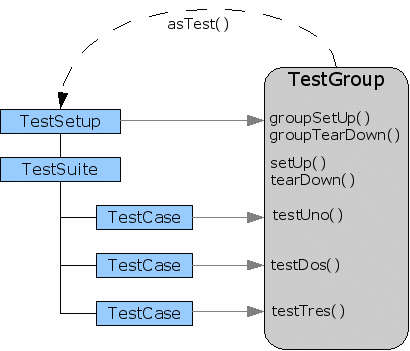TestGroups for JUnit
19 Dec, 2004
New users of JUnit often assume that there will only be one instance of their TestCase class (I did, at first).
In fact, each test-method is represented by a separate instance of the test-class. This isolation of test-methods is actually pretty sensible, since it means that (from the horse's mouth)
... each test will run with a fresh fixture and the results of one test can't influence the result of another.
If your tests are truly unit-tests, then re-creating a fresh fixture for every method should be fairly cheap, so it's not a big deal. BUT, it's a slightly different story if you're using JUnit as a framework for acceptance tests, or integration tests, or any scenario in which creating the required fixture/resource objects is costly.
My problem
On my current project, we have a large suite of web-app acceptance-tests written using HtmlUnit. We starting off writing tests something like this:
public PolicySelectionScreenTest extends TestCase {
public void setUp() throws Exception {
expensiveSetUpCode();
}
public void testPolicyTypeDefaultsToStandard() {
assertEquals("STD", screenFixture.getPolicyType());
}
public void testWindscreenOptionDefaultsToNo() {
assertEquals("N", screenFixture.getWindscreenOption());
}
}
It soon became obvious that re-running the
expensiveSetUpCode() for each test was - well - expensive, so
we starting looking for ways to reduce that overhead. An obvious way to do
it is to bundle several asserts into the one test, e.g.
public PolicySelectionScreenTest extends TestCase {
public void testInitialScreenStateIsCorrect() {
expensiveSetUpCode();
assertEquals("STD", screenFixture.getPolicyType());
assertEquals("N", screenFixture.getWindscreenOption());
}
}
There are a couple of problems with this, though:
- Test-methods get bloaty, and their names become less informative. This isn't ideal, as I prefer short test-methods, with names that describe the intended behaviour.
- Testing of a scenario may halt prematurely, when it could usefully run further and provide more feedback about what is or isn't working.
A solution
So, I developed a way of aggregating a number of related test-methods into a "TestGroup". Now our tests look more like this:
public PolicySelectionScreenTests extends TestGroup {
public void groupSetUp() throws Exception {
expensiveSetUpCode();
}
public void testPolicyTypeDefaultsToStandard() {
assertEquals("STD", screenFixture.getPolicyType());
}
public void testWindscreenOptionDefaultsToNo() {
assertEquals("N", screenFixture.getWindscreenOption());
}
}
A TestGroup instance can be converted into JUnit-ese easily, by calling
its asTest() method:
public static Test suite() {
TestSuite suite = new TestSuite();
// ... etc ...
suite.addTest(new PolicySelectionScreenTests().asTest());
return suite;
}
Alternatively, we have an extended TestSuite implementation that makes this a little easier:
public static Test suite() {
TestSuite suite = new GroupAwareTestSuite();
// ... etc ...
suite.addTestSuite(PolicySelectionScreenTests.class);
return suite;
}
Now, our original tests run faster (since the
expensiveSetUpCode() is only run once), but the test-methods
remain short and well-named. Woo-hoo! [cue weird little dance of joy].
But wait, there's more
As you might have guessed, there's a groupTearDown() to match
groupSetUp(). The normal setUp() and
tearDown() hooks are also supported, and run before/after each
test, as you'd expect.
A warning
Once we start sharing test-fixtures like this, we're effectively removing JUnit's built-in safety harness, and thus running the risk of tests infecting the results of other tests by "polluting" the fixture. There's no easy solution: you just have to be really careful. Guidelines:
- If possible, avoid putting any code that alters the state into the test-methods of a TestGroup.
-
If that's not possible, ensure you reset the fixture to a known state in
the
setUp()hook.
A peek inside
In my first attempt at TestGroups, I simply implemented the Test interface. Unfortunately, it's a fairly thin interface, and doesn't provide an API for navigating the hierarchical structure of a test-suite. If you want to explore the hierarchy, you'll have to assume that your test-suite will be constructed from TestCase and TestSuite objects - perhaps with the odd TestDecorator thrown in - and perform the required instanceof checks. If some new, unknown implementation of Test comes along, your assumptions are shot. Most IDEs are in this position, as they typically display the test-hierarchy. Thus, my original implementation didn't play nicely in an IDE environment.
So, instead, TestGroup.asTest() creates a structure that
adapts the TestGroup to look like a TestSuite. The suite is wrapped by
a TestSetup decorator that fires the groupSetUp() and
groupTearDown() hooks. The TestCases in the suite are
simple proxies that invoke methods on the shared TestGroup instance. Or,
in pictures:

Because the result is just a aggregate of core JUnit objects, it doesn't confuse IDEs in the way I described earlier.
The code
If you're interested in using TestGroups, or just want to take a look at the code, you can get it here.







Feedback